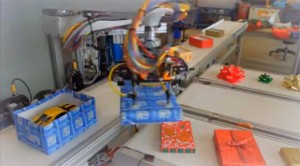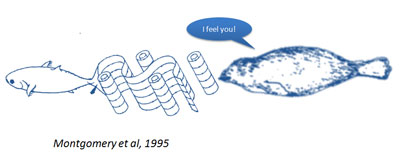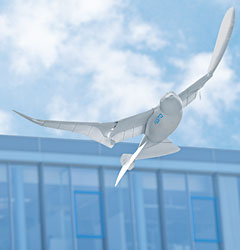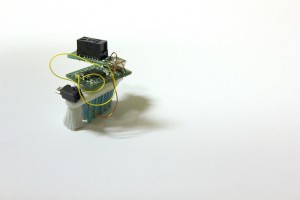This is a laser pendulum. The motor driving the pendulum turns on when the laser is blocked from contacting photo sensor. Each time the laser hits the sensor the motor switches direction.
This is a laser pendulum. The motor driving the pendulum turns on when the laser is blocked from contacting photo sensor. Each time the laser hits the sensor the motor switches direction.

While they are generally used for spot welding, positioning, and ergonomic lifts for moving objects that are too heavy for a human to move, the robotic arms with multiple degrees of freedom have become industry standard tools in just about any major, high-volume manufacturing facility. In this case, a few of the arms were repurposed to create the necessary motions in wrapping gifts with gift paper. This was for a theatrical trailer for GM, the automotive company during the holidays. Regardless, the robots did actually serve the purpose in folding paper in the proper shape and in the proper time period for different sized gifts to be wrapped for the public to witness. This display in technology helped the general public better understand the type of equipment used in producing the vehicles they drive on the roads today.
In general, the dryness of this text left me frustrated with the notions of utility and purposefulness. Was the article useful? Yes, I guess. Is its view that robots should serve as usefully as this text? Yes, perhaps even more so. So I came up with my own criteria for a robot that might un-service us as the antithesis. I was hoping to dig up an example of something really silly, but well made — without purpose, but suggestive of or referential to something interesting, critically or philosophically. And last criteria: aesthetically pleasing? (Or at least perhaps visually referential to something outside robotics?) I was pretty excited by the predator slugbot (p.49) and the ecobot that converts dead flies to electrical energy (p.53), both cited in the text. But damn, they look awful. And they suggest future improvement to humanity! Yikes, that sounds useful. So I’m not sure I’ve found any artist-made useless robots that really strike the note I’m looking for.
Instead of following the assignment exactly, per se, let me drag you through the mud that was my search tonight:
1) Non-aesthetic, utilitarian end of the spectrum: Seal Whisker Sensors

web.mit.edu/towtank/www/sealWhiskers.html
Oooo, sensor development! Obviously this is more on the straight science side, using biomimetic approach to robot design, and at this stage is purely utilitarian in order for AUVs to feel wakes…. Not unrelated to the Bristol Robotics Lab Scratchbot (p.55). But, hey, maybe it gives you underwater camera ideas, doesn’t it, Garret Brown?
But, NOT WHAT I’M LOOKING FOR.
4) Douglas Repetto’s “Nearly Human” project
music.columbia.edu/~douglas/portfolio/nearly_human/
“Nearly Human (one billionth of a human brain) is a deeply flawed physical metaphor for a human brain.
Like many brain (and other biological) metaphors, it is much too simple and mostly wrong. But it’s also an attempt at being a little bit right in ways that are non-typical for popular representations of brains.”
This seems pretty far on the “Art” side of the spectrum, and arguably might not be a robot, because I am not so sure there are any sensors in that mess. However, I think this project deals with some of the things discussed in the article as subject matter in an interesting way, since as you will see in Repetto’s notes, he is thinking about the role of metaphor in human-intelligence research, as well as the absurdity of the idea of even coming close to replicating the human brain.
Okay, weird. Cool. BUT NOT WHAT I’M LOOKING FOR.
1) Bartending robot

“Silly?” Check minus (not quite silly ENOUGH). Well made? Check. Without purpose? Uncheck, check, uncheck, check, whatever. If we debate this, we may be debating if alcohol truly serves a purpose. This ambiguity makes it all the more interesting. So, is it referential / suggestive of something interesting, critically speaking? Yeah, sure. An alcohol-serving machine / “companion” references the complexities of the questionable utility of recreational drugs, etc, and could be said, as you purchase your drink from it, to reiterate the numbing virtual structures of internet-era capitalism, eliminating the job of a grungy bearded or breasted barista who would stand in its place otherwise (whoa! but I think I’m giving it too much credit)… After all, who better to question what the model might be for the perfect human companion than the bartender?
However, do I find this bartender aesthetically interesting or pleasing? Rehhh. No. Falls into all the tropes of Robot-servitude and the aesthetic of plasticized human-features that I find fatiguing. The bowtie even throws it back to the butler-bots of science fiction, the analogue slave days of robotics! This stuff is amusing, but not what I’m looking for. The aesthetic and style of interaction seems to harken the text’s reference to conversational bots (In the humanoid robot companion section in the Robotic Futures chapter), which is written with a level of utility in mind that seems to pull the whole idea back into the realm of medicine or assembly line production. Maybe I don’t want a good lookin’ or a nice talkin’ bartender?
So, nice bartender? NOT WHAT I’M LOOKING FOR.
ALTHOUGH, this might be closer: www.gizmag.com/inebriator-robot-bartender/23974/
2) (Not unrelated to above) : Robotic Chefs
www.huffingtonpost.com/2012/06/18/robot-chefs_n_1601634.html
But equally problematic, in my humble opinion (from the point of view of “as art project,” perhaps)….
NOT WHAT I’M LOOKING FOR.
Okay, mission failed. But there’s some okay reverse-inspiration here.
A robot that flies like a bird – “Biomimicry”
Man has always had a fascination for flight. Starting with the wright brothers we have been inspired by nature – using wings and applying principles of aerodynamics learnt from birds. But the “smart bird” is something completely different, the smart bird is not inspired by nature but rather is a copy of it, an attempt to replicate it. The result is compelling. The team creates something that is in some ways surreal – a flying robot that looks natural. Research into robot aesthetics / movements / form / gesture is fascination because it’s through these mediums that we interface with the robot. They play a role in dictating our experience of the interaction – whether we come to accept the robot as a companion, tool or entertainer or reject it for being too different, unfamiliar and alien.

Sony AIBO—The symbol of the future
I Sensor + I Actuator = “Bristle”.
– Bristle uses a small vibrating motor to move.
– He avoids being picked up or touched.
– He uses an infrared distance sensor to perceive the word.
– After some persistence bristle will become accustomed to you and allow you to pick him up.

Electric Shock Wind Reprieve
A low-voltage electric shock is delivered to my arm.
When I blow on the wind sensor, I am granted a temporary reprieve from the pain. The duration of the break lasts as long as I blow times two.